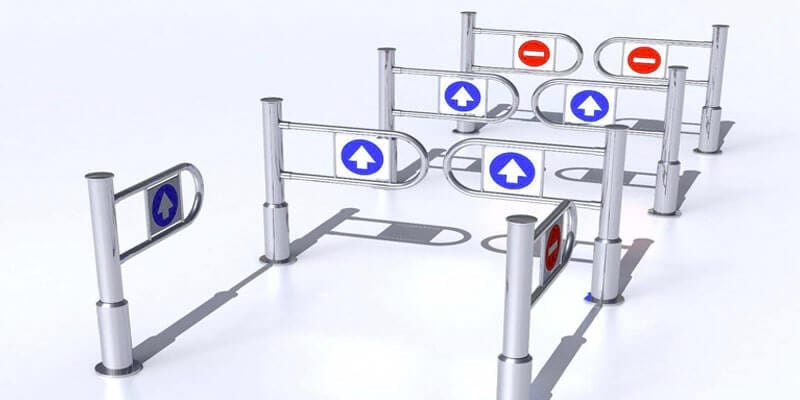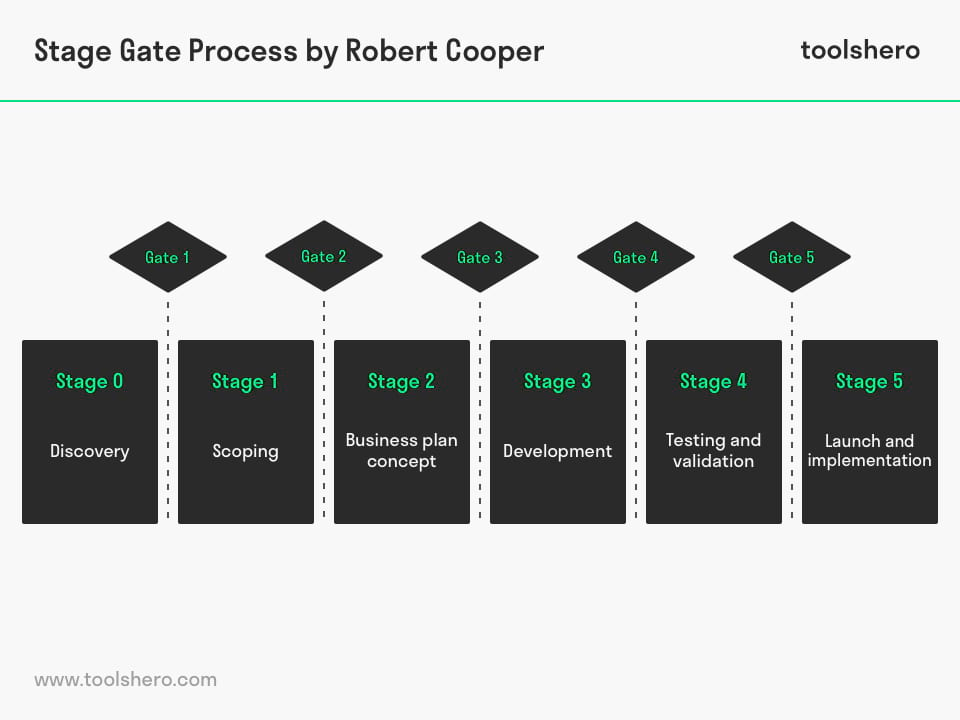Stage Gate Process by Robert Cooper explained

Stage Gate Process: this article explains the concept of the Stage Gate process, developed by Robert Cooper in a practical way. After reading it, you will understand the basics of this powerful innovation and project management concept. Highlights include: an explanation on what the Stage Gate process is, the different (sub-)stages of the model and what the advantages are. Enjoy Reading!
What is the Stage Gate process?
The State Gate process is a patented trademark of Robert Cooper. The model focuses on the innovation process and is also referred to as the waterfall process.
It is a project management technique, in which an initiative or project takes place, divided over several stages. These stages are separated by so-called ‘gates’; the decision points for whether or not to proceed to the next stage.
The stage gate model can be used when developing new products, process changes, quality control or improvements.
The Stage Gate process explained
At each gate, a decision is made whether to continue the process or not. This decision is based on the prognosis and information available at that moment and in most cases is made by a manager or steering committee. The quality of an idea is assessed at each of the gates.
This concerns the quality of the execution by a cross functional team or project teams, business motivation to continue financially and the action plan showing what needs to be done in order for the project to have a chance at succeeding.
After each gate, one of the following decisions can be made:
Go
The project is good enough to move on to the next stage.
Kill
The project is not good enough to develop further and is shut down right away.
Hold
The project is not good enough to continue to develop it at this moment, but not so bad that it needs to be shut down immediately. It is put on hold to possibly be resumed at a later date.
Recycle
The project is good enough to develop further, provided some changes are made.
Stage Gate model
The process consists of a number of stages, which are connected to each other by gates in the Stage Gate model. Each stage is designed to collect specific information:
- Stage 0: Discovery
- Stage 1: Scoping
- Stage 2: Business plan concept
- Stage 3: Development
- Stage 4: Testing and validation
- Stage 5: Launch and implementation
Depending on the size of the project, 2, 3 or all 5 stages are completed. A project that focuses on major product innovation will go through all 5 stages. A project with less risk will suffice with just stage 1 (scoping) and stage 2 (development of the business plan) and developing it to stage 4 (testing and validation).
With very small or simple adjustments, only stage 3 (development) and stage 4 (testing and validation) will be implemented. Examples are marketing requests or an application to modify an existing product.

Figure 1 – Stage Gate Process Flowchart (Cooper)
Stage 0: Discovery
This initial preparatory stage determines which project a company wants and is able to carry out. Ideas can be generated in brainstorming sessions.
Employees are not the only ones involved in this part. Customers and suppliers also provide useful information. An idea is first selected and then proposed. If the idea is not worth the effort, the gate closes here.
Stage 1: Scoping
It is all about portfolio management: evaluating the products and the associated markets. What are the product’s strengths and weaknesses and what can it bring to the user/consumer in terms of added value?
This stage takes all the possible threats from competitors into account. Based on the assessed threat, production will or will not continue. The greater the threat, the greater the chance that the gate will close.
Stage 2: Business plan concept
Now that the product is impervious to competition, a business plan is drawn up.
This is the last stage of concept development and is crucial before the starting with development of the actual product. This stage is very labour-intensive and includes sub-stages that need to be completed:
Product definition and analysis
The customer value is determined by finding out which benefits the product offers and what conditions and functions it must meet. This information can be retrieved with the help of interviews and surveys. We also look at the environment and the competition.
Creating the business plan
In this document the product is described and defined, including the legal health and safety requirements.
Creating the project plan
This plan contains a list of all tasks that are planned during the entire development process, and the people who will carry them out. The expected launch date can also be found in this plan.
Feasibility review
This last step is the most important one of the stage. It’s the business case.
The business case includes a feasibility study in which different departments assess the plan’s chances of succeeding. If, after this stage, the business case appears that the business concept does not have sufficient potential to generate turnover, the gate will close.
Stage 3: Development
During the product development process stage, the plans from the previous steps are carried out and simple tests are conducted. For example, at this stage customers can be asked what they think of the product.
The development team also creates a timeline with specific milestones that have to be achieved. This timeline can be revised and updated regularly.
It also incorporates multi-functional teamwork; different departments provide input with expert advice. The cross functional team ultimately results in a product prototype, which will be extensively tested during the next stage. The gate will remain closed if the product has not been sufficiently developed.
Stage 4: Testing and validation
This covers product testing and validation. They also look at the manufacturing process and how the product is accepted by customers and the market. This also means that a number of sub-stages are completed during this stage:
Near testing
The purpose of this test is to identify possible production errors or other issues. It is no longer a prototype; the product is almost ready to be sold.
The groups that carry out this test are closely tied to the organisation. They include staff, regular customers and suppliers.
Field testing
In this part, the product is tested in the field by various participants who can make a valuable contribution. This is usually done with the help of customers.
It is important to find out whether this target group is interested in the product, which characteristics they consider important and in which context the product will be used.
Market testing
This test is optional If the product is offered in the market, it has already passed through the previous test stages. This means that sometimes, after a period, the product is assessed to see whether it sufficiently matches the needs and wishes of the consumer.
The product is usually pretty much in its final form after testing. However, there also has to be a good marketing plan to launch the product. If not, the gate to the next stage will remain closed.
Stage 5: Launch and implementation
The marketing strategy comes into play during the launch process in the process. The product is ready to be launched, which will include a fair amount of hype, by means of for instance an advertising campaign, free publicity (press releases) and interviews.
An estimate is made about the quantity that will be sold. Policies regarding production, inventory and distribution must be set up. The sales team is predominantly responsible for ensuring a smooth process.
Stage Gate process and effective gates
The transitions between the different stages are in the Stage Gate process monitored by the gates mentioned earlier. These gates have the added function of putting a stop to the development of weak projects in order to prevent unnecessary work.
After all, that can cost a lot of time and money. In that sense, the gates are the points that provide an overview of the project so far. This is the crucial moment to make go / kill / hold / recycle decisions and set priorities. It is important that these ports have clear and visible criteria beforehand.
In most cases this is done based on components that the project must meet at that specific level in development. If the project fails to meet the criteria, the decision is made to stop developing further.
Advantages of the Stage Gate process
The Stage Gate process has a number of advantages. The most important can be found below:
- Reducing production errors
- Reducing errors and waste of raw materials
- Internal focus on the right projects
- Good communication between different departments
- Clarity about all planned projects
- Good communication between external stakeholders, including customers, partners and suppliers
It’s Your Turn
What do you think? What are your experiences with the Stage Gate process? Do you recognize the practical explanation or do you have more suggestions? How do you determine whether to continue with a process or not?
Share your experience and knowledge in the comments box below.
More information
- Cooper, R. G., Edgett, S. J., & Kleinschmidt, E. J. (2002). Optimizing the stage-gate process: what best-practice companies are doing. Research-Technology Management, 45(5), 21-27.
- Cooper, R. G. (1990). Stage-gate systems: a new tool for managing new products. Business horizons, 33(3), 44-54.
- Website Stage-Gate International: https://www.stage-gate.com/
How to cite this article:
Mulder, P. (2018). Stage Gate Process (Cooper). Retrieved [insert date] from Toolshero: https://www.toolshero.com/innovation/stage-gate-process/
Published on: 09/09/2018 | Last update: 03/31/2023
Add a link to this page on your website:
<a href=”https://www.toolshero.com/innovation/stage-gate-process/”>Toolshero: Stage Gate Process (Cooper)</a>













5 responses to “Stage Gate Process by Robert Cooper explained”
I couldn’t get more info. 1 to open – is there an issue with the link? – could it be sent to me
I found the rest very interesting
cheers Warren
Hi Warren, thank you for your feedback. The first link is not available anymore. We will update it. The other links are still available.
Doing this during Stage 2 does not seem realistic: Creating the project plan. This plan contains a list of all tasks that are planned during the entire development process, and the people who will carry them out. The expected launch date can also be found in this plan. That is often a tremendous amount of effort requiring significant cross-functional resources to pull off. This is large investment of company resources going into something that is not approved for development.
it is clear and simple article , and I understood that the decision making tools ( stage gates ), and supposed to have some graphics to get more clarifications
What’s the difference between front end engineering design and stage-gate process in project management? Totally different ? or interchangeable?